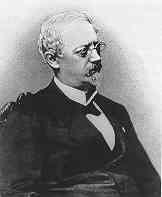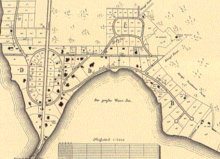Wilhelm Conrad (banker)
Carl Heinrich Wilhelm Conrad (born June 18, 1822 in Berlin ; † December 24, 1899 there ) was a German banker and landowner. He founded the Alsen colony , from which the Wannsee community later emerged.
life and work
After Conrad had attended the municipal trade school in Berlin, he completed a commercial apprenticeship in Magdeburg with a degree at the drug and paint store Rüdiger & Pilarek. He then went to France , where he joined the Henrion & Bertier company in Paris in 1843 , founded a chemical factory and gained further commercial experience in a glassworks near Le Bourget . In 1846 he married Emilie Schucht, with whom he had four children.
At the age of 38 he returned to his hometown and in 1860 became a personally liable partner of the major Prussian bank Berliner Handels-Gesellschaft . In 1863 he drew up the plan to build a villa colony on Wannsee and bought the " Stimmingschen Gasthof " on Königstrasse next to today's Wannsee Bridge with the associated 300 acres of heathland. He then had the Lenné student and later director of the Berlin City Garden Authority, Gustav Meyer, develop a road and development plan, whereupon in 1868 the parceling and sale of the land began. In 1870 Conrad had the inn torn down and his Villa Alsen built in its place .
His brother-in-law Louis von Colomier had taken part in the conquest of the island of Alsen (storming the Düppeler Schanzen ) in the German-Danish War in 1864 , whereupon in 1872 the entire villa colony was given the name Alsen out of “patriotic sentiments” . The Wannsee community emerged from it. Conrad found the historically fitting monument for his colony in the Flensburg lion , of which he had a zinc copy made in 1874 (older information 1869) and placed in the elevated mountain park. According to the information board on site, the monument was “in addition to its decorative purpose also a sign of the admiration that Wilhelm Conrad had” for Prince Friedrich Karl Nikolaus of Prussia , the victor in the Second Schleswig War . The sculpture of the late Classicist monumental sculpture, which was extensively restored in 2005, is now on the banks of the Wannsee near Heckeshorn .
The Alsen colony was supplied by its own waterworks, which was followed by an electricity company in 1890 . Conrad was also the initiator of the Wannseebahn built in 1874 (a branch line of the "Berlin-Potsdam-Magdeburg Railway") and chairman of its supervisory board . That is why it was popularly known as the “Wahnsinnsbahn auf Conrad” or “Bankierzug”.
Conrad was honored for his services with the title of Privy Councilor of Commerce . In 1883 he had to resign as a partner in the Berliner Handels-Gesellschaft, as the bank had come into a critical position due to violent failures in its Russian business.
Wilhelm Conrad died in Berlin in 1899 at the age of 77. He was buried in a hereditary funeral in the New Wannsee Cemetery in Lindenstrasse, which was laid out in 1887 on land he had bought. The corner wall grave made of red clinker brickwork in the form of a neo-Romanesque aedicula with triangular gable is crowned by a cross. It is located near the Protestant Andreas Church, which was also donated by Conrad and built in 1895/96 .
By resolution of the Berlin Senate , the last resting place of Wilhelm Conrad (grave location Li AT 29) has been dedicated as an honorary grave of the State of Berlin since 1995 . The dedication was extended in 2018 by the usual period of twenty years.
The Conrad elementary school in Berlin-Wannsee is named after him, as is Conradstrasse, the northern section of the Ringstrasse around the southwestern part of the former villa colony.
literature
- Karl Wolff: Wannsee and surroundings - past and present . 5th edition. Elwert and Meurer, Berlin 1976.
- Ingo Krüger : Little Wannsee. Aschenbeck & Holstein, Delmenhorst u. a. 2004, ISBN 3-932292-57-X (= country houses and villas in Berlin & Potsdam. 2).
Web links
Individual evidence
- ^ Hans-Jürgen Mende : Lexicon of Berlin burial places . Pharus-Plan, Berlin 2018, ISBN 978-3-86514-206-1 . P. 659.
- ↑ Honorary graves of the State of Berlin (as of November 2018) . (PDF, 413 kB) Senate Department for the Environment, Transport and Climate Protection, p. 14; Retrieved on May 19, 2019. Recognition and further preservation of graves as honorary graves of the State of Berlin . (PDF, 369 kB). Berlin House of Representatives, printed matter 18/14895 of November 21, 2018, p. 1 and Annex 2, p. 3; accessed on May 19, 2019.
- ↑ Conradstrasse. In: Street name lexicon of the Luisenstädtischer Bildungsverein (near Kaupert )
| personal data | |
|---|---|
| SURNAME | Conrad, Wilhelm |
| ALTERNATIVE NAMES | Conrad, Carl Heinrich Wilhelm (full name) |
| BRIEF DESCRIPTION | German banker and landowner |
| DATE OF BIRTH | June 18, 1822 |
| PLACE OF BIRTH | Berlin |
| DATE OF DEATH | December 24, 1899 |
| Place of death | Berlin |


